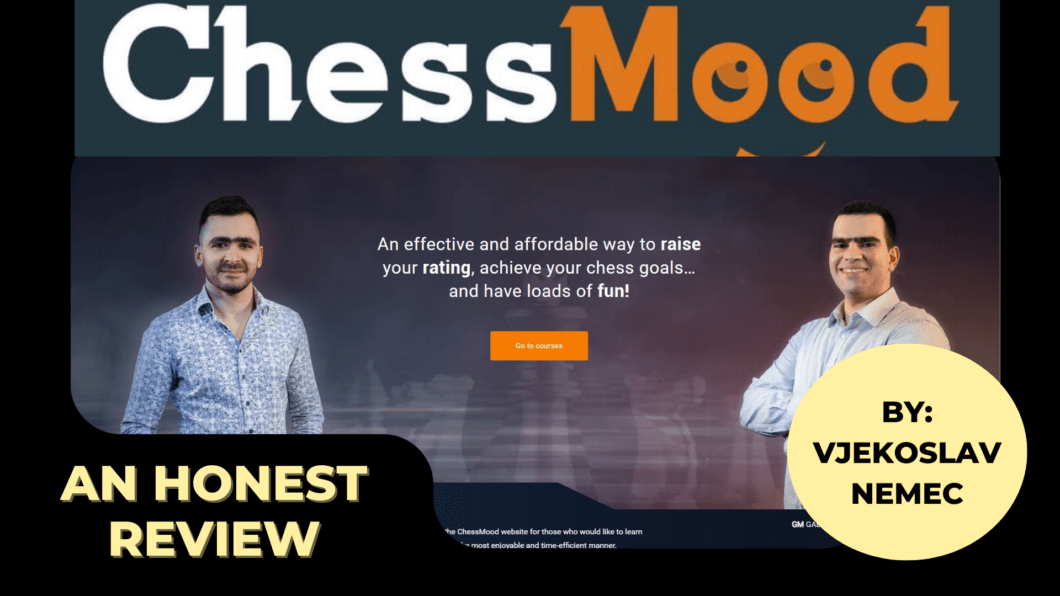Disclaimer: The following article was the result of the partnership agreement between the author and Chessmood. Chessmood kindly provided me with free access to the features and functionality of their website for the purposes of review. In return, I have included several affiliate links in this article offering Chessmood’s products at a 20% discounted value. If you click on an affiliate link on this website and then make a purchase of the Chessmood product or service, I as the author of the article will receive compensation.
Irrespective of that, throughout my review I have refrained from overly glorifying their services and products and tried staying as objective as possible.
Hope you will find it useful and that the article will be helpful in deciding whether ChessMood and its products/services are the right for you.
Table of Contents
INTRODUCTION
In the recent few years, the chess world has seen a very significant increase in the number of digital platforms offering different types of chess services. Previously on this blog, I have written about Chessable, 1 a company that sells digital, interactive chess courses based on their space repetition technology 2 and about Forward Chess, an interactive chess e-book reader/application.
In this article, I will write about another digital chess platform/company selling chess content – ChessMood.
WHAT IS CHESSMOOD?
THE CHESSMOOD PLATFORM
Chessmood is a platform that aspires to be your go-to place for everything related to chess improvement. It was founded by the Armenian Grandmaster Avetik Grigoryan, who is the main driving force behind the entire business/project. Apart from him, the team is comprised of other renowned Armenian Grandmasters such as Gabuzyan Hovhannes, Hrant Melkumyan, Robert Hovhannisyan, and Samvel Ter-Sahakyan, as well as the well-known educator and book author, GM Johan Hellsten. 3

The ChessMood team of coaches, led by founder GM Avetik Grigoryan
The first thing you notice when you visit their website at chessmood.com is the professional and slick design of their website, which was developed by a specialized development company called AIST. The website is very concise and easy, but not the point of being overly simplistic. It is very easy to find all the relevant info about Chessmood, its products, team, pricing plans, blog posts, etc.




The home page of ChessMood.com
From the images above, you can also notice that the website is full of the typical „improve your rating and achieve your goals“ marketing narrative that has become standard in the chess business world. But one thing I like about Chessmood is that their philosophy doesn’t necessarily correlate with that, typically shallow, business lingo. For example, on their blog, you can find articles such as If You Want To Achieve More You Need To Deserve More that talk very realistically about goal setting and what you can expect from your chess improvement.
Also, I have listened to several interviews with the founder, GM Avetik Grigoryan and I have to say I really like him. I genuinely think he is not your average „I just want to increase revenue“ type of businessman. He strikes me as a very humble, honest, and positive guy and I do think he genuinely cares about his students/members.
This might not be the most relevant aspect of an „objective“ review of a business, but in my book, the narrative behind the business is almost as important (if not even more important) than the business itself.
THE CHESSMOOD PRODUCTS
Chessmood offers its customers a variety of chess-related products. The bulk of their offer consists of a variety of chess courses on different topics, although they also provide their paying members with regular streams, webinars, and a 1-1 call with a GM member from the Chessmood team that helps you set your chess goals and create a study plan depending on your availability. 4
Another benefit of joining Chessmood that is heavily emphasized in their marketing is the community aspect. Paying members of the website gain access to a specialized, non-public forum where they can communicate with the team of Chessmood Grandmasters and other paying members. The idea is that belonging to a community will help with motivation AND accountability when it comes to sticking to one’s study plan. 5
THE CHESSMOOD BUSINESS MODEL
The majority of these products/services can be obtained exclusively by subscribing to one of the two monthly/yearly subscription plans:
- Essential plan – for a price of 19 USD/month, 228$/ year, this plan gives you access to all the chess courses on the website (as long as you remain subscribed!)
- Pro plan – for a price of 39 USD/month, 468$/year, this plan gives you access to all of the Chessmood products mentioned above – courses, streams, webinars, and the special PRO forum

Chessmood’s Pricing Plans
Thus, the majority of Chessmood’s content can be accessed exclusively by subscribing to one of the two plans mentioned above.
The only exception are Chessmood’s chess courses. When it comes to access to the courses, Chessmood’s business model is nominally freemium. Every visitor of the website can access a small sample of every chess course on the website in order to get a taste of what the course is about and how do the courses on Chessmood look like, in general.
For certain courses (mostly those devoted to openings), a substantial amount of the content is available for free. For example, for the course Countering All The Sicilian Sidelines, almost 1 hour out of 4, or roughly 25% of the content, is available for free. Something similar can be observed for the course Nightmare of Rossolimo (45 minutes out of 210 minutes, or roughly 21% is available for free), Benko Gambit (43 minutes out of 3 hours and 27 minutes, or roughly 20%), and a handful of others.
However, it has to be mentioned that the % of the content available for free/as a sample for certain courses is extremely low. For example, in the course Spartan Shield, out of the total 107 minutes of video, only 2 minutes and 15 seconds – or 2.1 % – are available for free.

Excerpt from the course Spartan Shield. Only the Course Overview – marked with “Unlocked”, is available for free
Similar numbers are apparent for some other courses. For example:
- For the course Tactic Ninja, ~39 minutes out of 19 hours 26 min are available for free, or roughly 3.3%
- For the course 100 Classical Masterpieces, ~ 1 hour of recording out of 26 hours and 4 minutes is available for free, which tantamounts to roughly 3.8%
- For the course Attack Like a Viking, only 5 minutes out of 6 hours and 26 minutes of recording, or roughly 1% of the course, is available for free.
Thus, even though Chessmood does nominally run a „freemium“ model, the usefulness of this model is quite limited. Given that the entry barrier for the „Essential“ program is relatively low, it is clear that the intention is to motivate every visitor of the website to enroll in one of the paid programs as soon as possible.
One could make an argument that this is at the core of any „Freemium“ business model, but I still don’t particularly like how it was implemented for Chessmood. I feel that the „Freemium“ model of some of their competitors, such as Chessable, is vastly superior as it provides you with more content AND with a better insight into the design of their courses and the features of the platform.
But I digress. When it comes to Chessmood’s chess courses, apart from obtaining access via subscribing to one of the plans mentioned above, it is also possible to purchase them individually and separately from the aforementioned pricing plans.
This brings me to the next part of the review/article.
THE CHESSMOOD COURSES
THE CHESSMOOD COURSES – OVERVIEW
As mentioned earlier, the core of Chessmood’s business/platform is a variety of chess courses, devoted to different aspects of the game. At the moment of writing, Chessmood has around 60 different chess courses featuring more than 300 hours of video recording.
The courses can all be found on the Chessmood course page and are divided into 9 different categories:
- Rating Booster (to get to 2000 level) – Courses on general chess topics such as tactical patterns, mating patterns, and middlegame and endgame basics, marketed for players at the 800-2000 rating level. 6

- Simplified ChessMood Openings (for 800-2000 level) – a set of 4 opening courses, tailored for the players in the lower-rating sphere (800-2000 level).

- Step-by-step opening repertoire for White – A full repertoire for White based on the first move 1.e4, advertised for players in the 1800-2600 rating range.

- The refutations of abracadabra gambits – a set of 4 courses devoted to refuting some bad but tricky gambits such as the Latvian Gambit, the Elephant Gambit, the Stafford Gambit and the Colorado Gambit.

- Step-by-step opening repertoire for Black – an opening repertoire for the Black pieces based on the Accelerated Dragon and the Benko Gambit.

- ChessMood openings in practice – Best of the streams – a set of streams where GM Gabuzyan Hovhannes employs the openings recommended in the aforementioned Chessmood courses.

- Must-know classical games (commented by Grandmasters) – a set of 3 courses devoted to a total of 300 must-know classical games.

- Middlegame Mastery – a set of 6 courses on different middlegame topics.

- Endgame Mastery (Step-by-step) – a set of 6 courses devoted to different endgame topics.

It has to be mentioned that not all of the courses mentioned above are yet finished. Some of them are future projects, while some of them – such as „100 Classical Games“ courses are ongoing projects that haven’t yet been completed and that get updated on a regular basis.
Now – even though I have commended the professional outlook of the Chessmood website earlier, when it comes to the courses page, I find its functionality a bit lacking. My main issue is that there is absolutely no way to filter the courses in any meaningful way (say by name or the author), nor a way to search them, say, by their name. It is true that all the courses are presented on the courses page, but if you want to navigate to a specific course, you have to manually scroll down the page until you find it.
Secondly, I think it is far from optimal that the course title is virtually the only info available on the course page. How exactly is the user supposed to know what exactly is the course „In Gabuzyan’s Mind“ or „Happy Pieces: The Art of Keeping Your Army Happy“ about? It is true that it is possible to get more info about each individual course by clicking on the course on the list, but I am personally really lacking more info on the main courses page – either in terms of tags, categories, the author, short description, or something else.
Another problem for me personally is that blurbs on pages dedicated to individual courses are often way too short and lacking in specific information about the course. This is particularly apparent when it comes to Chessmood’s opening courses, for example, the course devoted to the Accelerated Dragon for the Black pieces.

From the course description above, it is not immediately obvious:
- What exactly does the course cover?
- How is the material structured and organized?
- What are some of the recommended lines in critical tabiyas of the variation?
- etc.
It is true that some of this info can be accessed by scrolling a bit further down the page and checking the course chapters. 7 But the amount of information you can extract about a specific course in this way is limited, not to mention it is far from optimal to expect your customer to navigate the website very deeply in order to obtain information that can be considered basic.

On the other hand, we all know it is far more important what is on the inside rather than what is on the outside 8. Blurbs and course information are nice to have and all that jazz, but isn’t it way more important how the Chessmood courses actually work/look?
I definitely agree that the quality of a chess course is by far the most important factor. In the next part of the article, we will take an in-depth look at the inside of Chessmood courses and discuss all the relevant details – from the course interface to their content.
AN IN-DEPTH LOOK INTO CHESSMOOD COURSES
In order to start going through a Chessmood course, you have to select a course you want to study, go to that course page, navigate down to the „Lesson Plan“ toolbar with sections (that can be seen in the previous image), and then click on the chapter of the course you want to study. For the purposes of this article, let’s assume we want to study chapter 6. Be5! Lupulescu C. – Iturizagga of the aforementioned Maroczy Bind course. 9

After clicking on the desired chapter, we are taken to a new tab is opened that consists of the video presentation window on the left-hand side and the course structure with chapters on the right-hand side:
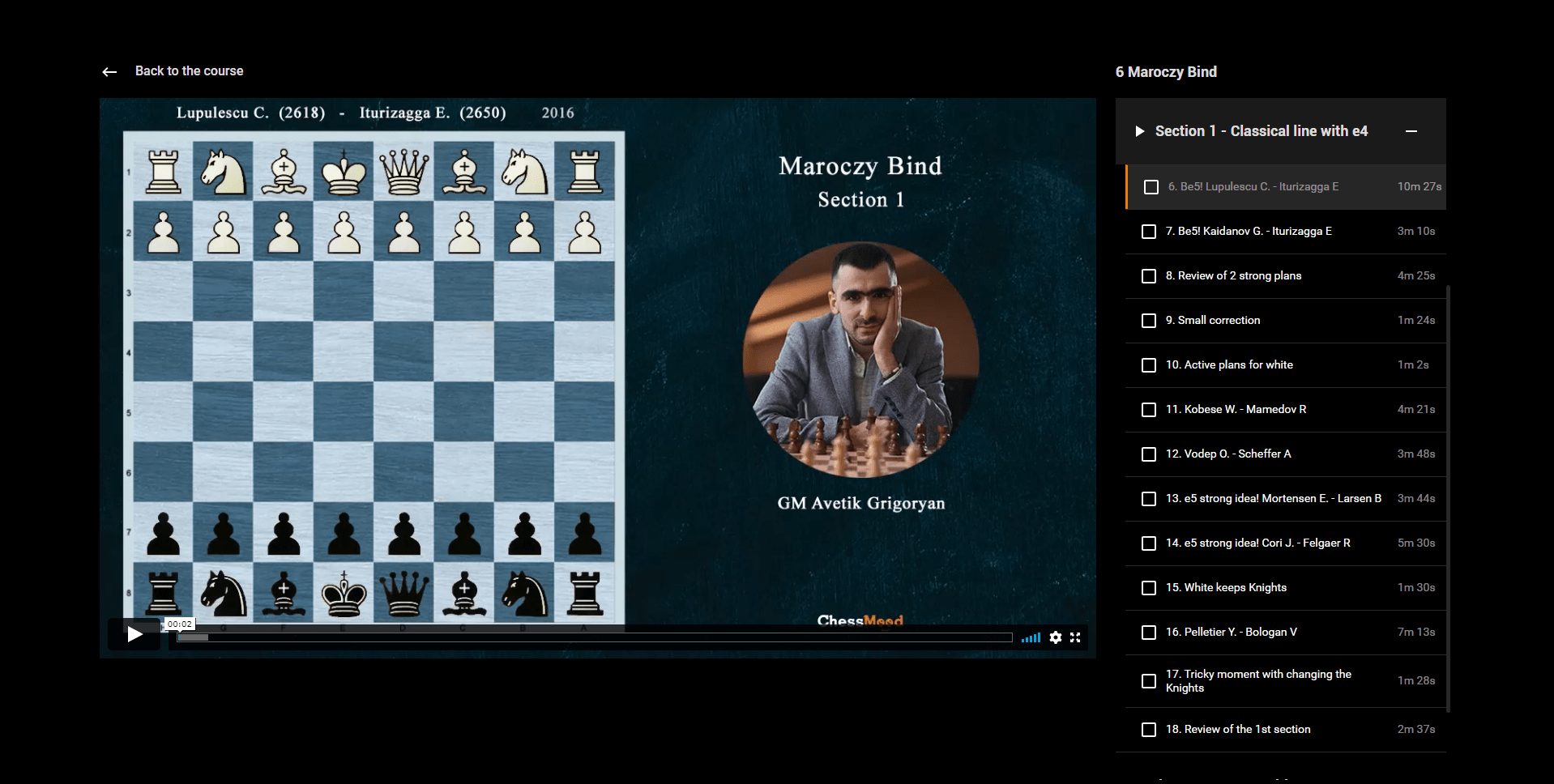
This window/tab is what represents the interface of the Chessmood courses and it reveals what the courses actually are – a series of video lectures devoted to different topics. The board visible in the image above is part of the video interface and is only used by the presenter to showcase games/game fragments discussed in the video. It is not interactive, which means that the user has no way of accessing it or moving the pieces on a separate part of the interface as the video is going on.
The interface is fairly intuitive and easy to use, although I have experienced minor technical difficulties (lag and delay) when trying to skim through the video of one chapter, or when switching between videos for different chapters.
The videos themselves are reasonably well-made from a technical perspective. 10 In most of the video, the presenter’s camera is off, but the sound is crystal clear and the presentation of the material is relatively seamless and fluid. Even though English is clearly not the first language of Chessmood’s team and even though some users might prefer native speakers such as Sam Shankland, I personally haven’t had any issues with it.
What was an issue for me personally, though, is the format of Chessmood courses. As mentioned earlier – the courses are exclusively available in video format and for the majority of the courses, the user doesn’t get access to any additional chess content in any format whatsoever.
Even when the .pgn file is provided within the course, it usually comes without any commentary or proper formatting and it more resembles a draft file that requires a lot of work on rather than a finished product:

Since I genuinely think video only format is one of the least efficient formats for focused chess studying due to its inherent tendency to foster passive learning, this is, in my opinion, a very serious drawback of Chessmood’s courses compared to, say, Chessable courses, where you get access to the course in the MoveTrainer format and where the video is also synced to the content. Even ModernChess provides you with the .pgn of the courses upon purchase and I would personally always prefer the product that has only chess content rather than the product that only has video content.
On the other hand, as for the actual content of Chessmood courses/videos, from what I have seen 11 it is actually of very reasonable quality. I thought the „100 Classical Games“ series is a fantastic trio of courses that is quite unique on digital chess platforms. 12 I also like how they not only present variations but typical ideas and key concepts in their opening courses and I also think the split of the course material into the „Less Advanced“ and „More Advanced“ section was reasonably well-made.
It is very hard to say whether the content of their courses is better than the content of their competitor’s courses 13, but I also think it does not necessarily lag too much and that it does provide you with sufficient chess value. It does seem to me that the Chessmood team of grandmasters is a bit more aware of the needs of lower-rated players 14 than your average chess grandmaster and I think it is obvious from their courses that they try to keep those needs in mind.
In fact, due to this attunement to the needs, but also due to the fact they don’t provide you with the actual chess content of their courses in any shape or form, I personally think their catalog is most suited precisely for the player in the aforementioned rating range.
Especially if you also take the size of their course library into account. This leads me to the next point of the article.
SIZE OF THE COURSE LIBRARY
Even though Chessmood’s course library is relatively sizeable and even though they have some very unique courses (I really like their compilations of 100 Classical Games), it is still significantly smaller compared to the course libraries of some of their direct competitors, such as Ichess.net, Chessable or even ModernChess. 15
This is especially apparent if we consider their offer of opening courses. If you are not a 1.e4 player or an Accelerated Dragon player, you essentially don’t have an option on Chessmood that would fit your needs. And even though everyone is obsessed with studying openings these days, I think their importance increases as your rating increases, which is another reason why I think Chessmood is primarily suitable for players at the lower end of the rating spectrum.
PRICING OF THE CHESSMOOD COURSES
Now, the main thing Chessmood does have going for them is the pricing model. As explained earlier, for a relatively low entry-level monthly fee of 19.99$ you can gain access to ALL of the courses on the website 16 As far as I know, no other platform/company provides you with access to so much content for such a low price.
The drawback to such a subscription-based business model is obvious – your access to the courses lasts as long as your subscription to one of the plans mentioned above. With that being said, it is also possible to purchase individual courses – even if you are not a Chessmood subscriber – and gain lifetime access to their courses. But in contrast to their subscription plans which are quite affordable, the individual course prices are extremely high. For example, the course The Mating Matador, covering basic Checkmate Patterns and featuring a total of 5 hours and 47 minutes of video recording, is priced at 125$, or roughly 20$ per video hour.
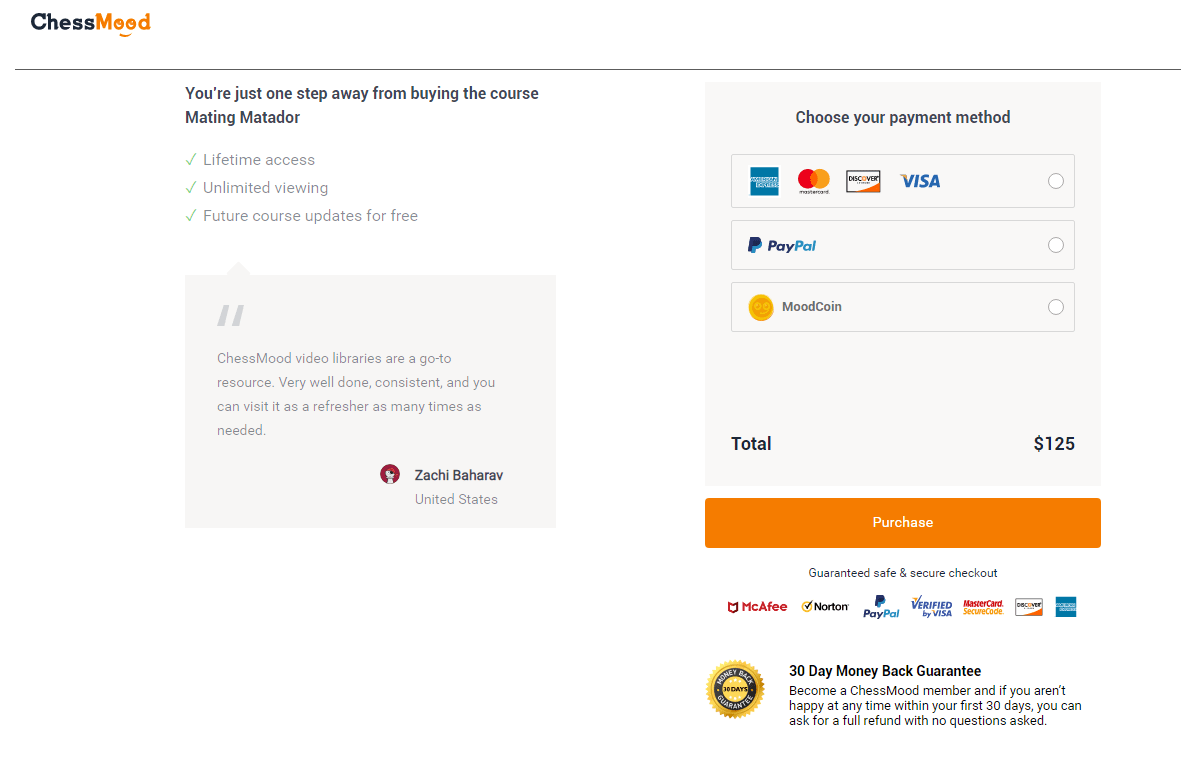
For comparison, a course on the equivalent topic on Chessable called The Checkmate Patterns Manual features 10 hours of video and costs 140 EUR (full price) or 75 EUR (on discount) – and this price also includes access to the course in the Chessable MoveTrainer format.
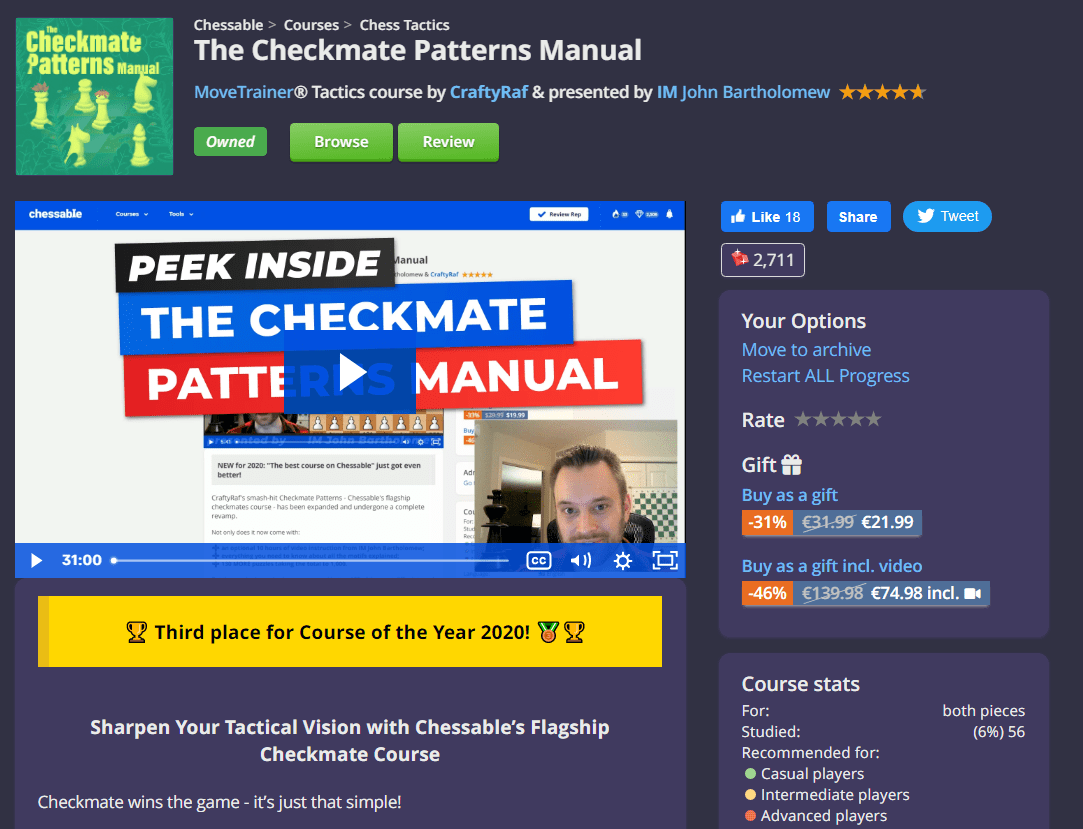
Other Chessmood courses are priced very similarly and it is safe to say that buying them individually is definitely not the smartest way to use your hard-earned money.
I actually think this pricing of individual courses is intentional and that the goal is to make the subscription model much more appealing. This is indirectly confirmed by numerous „subtle“ pitches of the subscription plans – even when the user considers buying an individual course. To begin with – on every individual course page there are two purchase options:
- Let’s go button that redirects you to the page describing the subscription plans
- Get a lifetime access link that allows you to buy the course individually
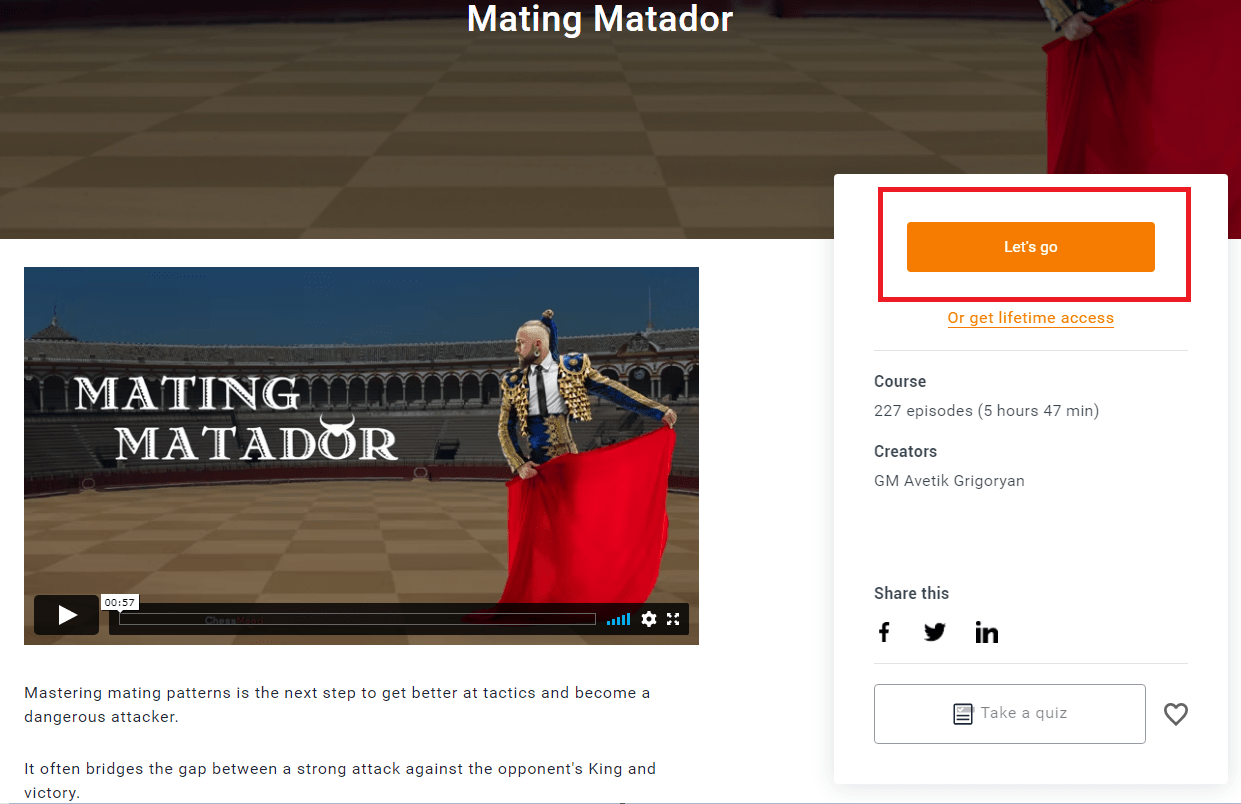
You can notice that the„Let’s go“ button is much bigger and more pronounced. Furthermore, upon clicking on the „Get lifetime access“ link, you are not immediately redirected to the checkout page – first, the following pop-up window appears:
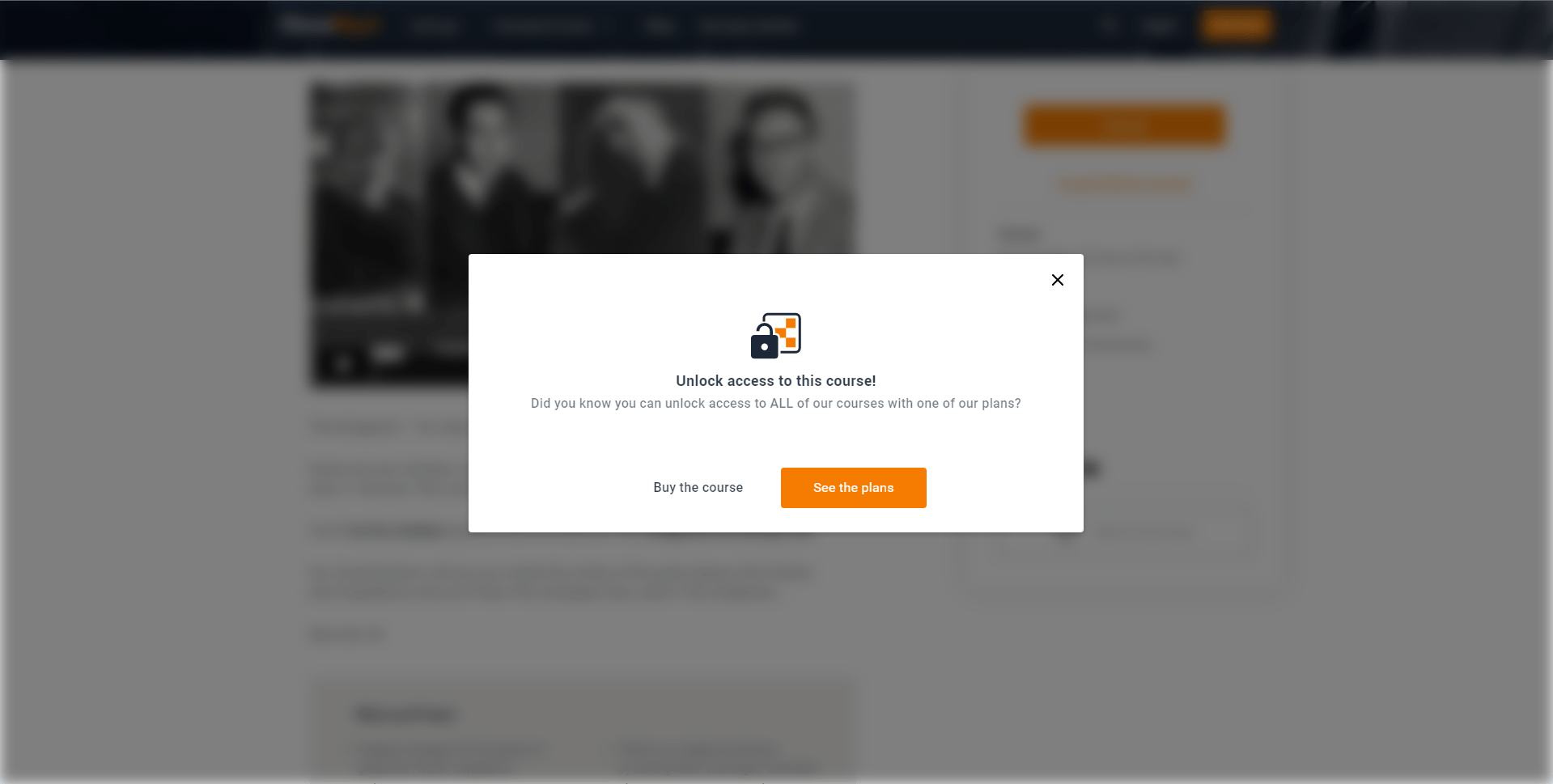
Once again you can see two options:
- Buy the course redirects you to the checkout page for the individual course
- See the plans redirects you back to the page describing different subscription plans
OTHER CHESSMOOD PRODUCTS
As mentioned earlier, aside from the chess courses, Chessmood also offers some additional products/services that can only be unlocked by becoming a PRO member. These include
- 1-on-1 call with one of the grandmasters from the Chessmood team where they help you set up a training plan based on your time, goals and availability. I think that 1-1 call with the member of the Chessmood team and the creation of the study plan is a very valuable service 17 as it helps with time distribution, focus, and accountability. Do note that this service is available elsewhere as it is provided by a number of chess coaches out there, 18 but here it is available at a lower rate and a part of a wider package.
- access to their regular streams, seminars, and webinars (both future and past ones)
- access to The Chessmood Forum where you can communicate with other users and the members of the Chessmood team. From what I have seen, the forums are quite active and Chessmood team members also answer users’ questions with regular frequency.

A list of upcoming seminars, including a 1-1 call with new Pro Members

A list of past seminars available on demand
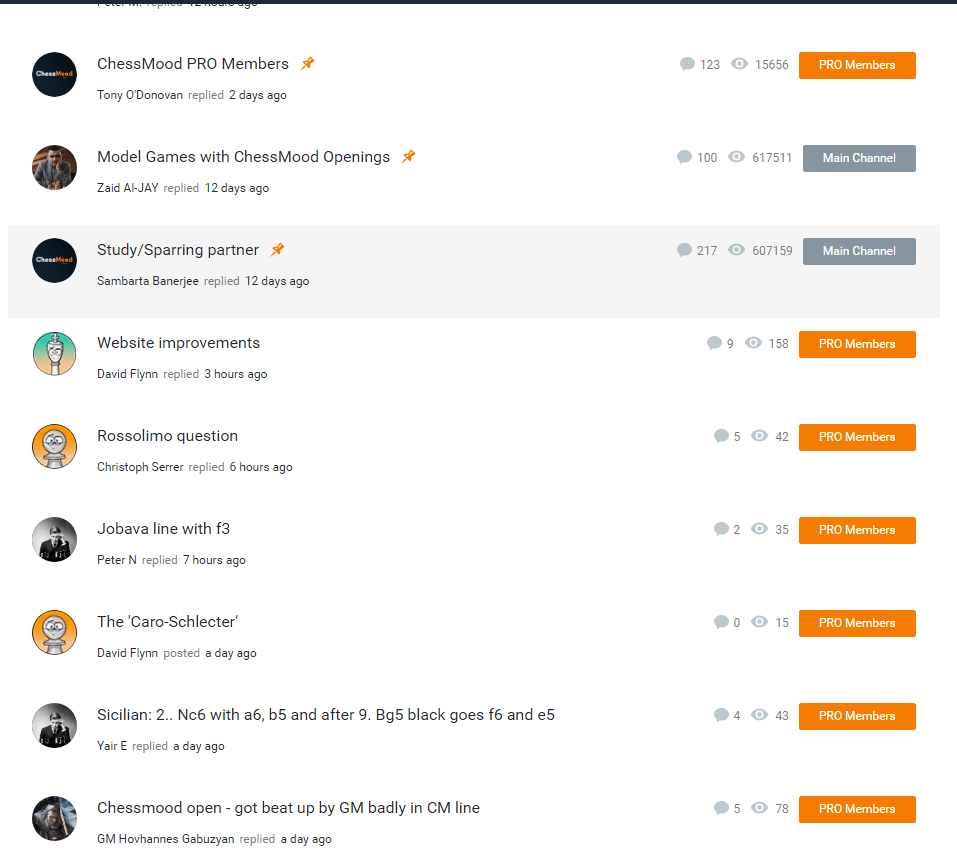
ChessMood forum with its designated section for PRO Members. You can notice GM Hovhannes Gabuzyan replying in a thread just one day before the screenshot was taken
It seems to me 19 that these additional products do offer the members quite some value – at a reasonable price. As a matter of fact, I am somewhat surprised that Chessmood doesn’t have a subscription model that offers access only to these products, as I have the feeling many people that are not necessarily interested in Chessmood courses could be interested in the rest of the PRO plan.
Of course, one could argue whether 1-1 call, forums, and seminars are worth an additional 20$ (the difference between the Essential and the PRO plan), but when we compare that price to, say, Killer Chess Training’s monthly subscription price of 149.00 EUR, I think we can all agree it is quite affordable. 20
CONCLUSION
Now, given that we are approaching the end of this article, I know many of you might be wondering: „Thank you very much for this amazing, insightful and super-accurate review Vjeko, you sexy beast, 21 but you still haven’t told me the answer to the most important question – is ChessMood worth it? Is ChessMood the right thing for me?“
It is a very difficult question to answer. On one hand, ChessMood provides you with a LOT of content for a very reasonable monthly subscription price, which makes it a good choice for people relatively newer to the game, people with limited budgets, and people who don’t necessarily want to spend a lot of money on chess.
But on the other hand, the presentation, variety, and quality of the content are lacking in many regards compared to what their competitors have to offer. I feel this makes their program less appealing particularly to players on the higher-rating end, for reasons outlined above.
Long story short, I don’t think there is a clear answer to the question posed above. I don’t think subscribing to ChessMood is a waste of time and money as I am sure you can get a lot from the content they provide, but I do feel it is a bit more difficult to use their products in an efficient and fun way compared to the products of their competitors.
But no matter what you decide, as long as you put in the hours and actually try to go through the material you purchase, results should come!
Ultimately, it is all up to you!
- A post I will probably update/rewrite from scratch in the near future
- A company I ended up working for 2 years soon after writing that article
- The author of the well-known trilogy Mastering Chess Strategy, Mastering Opening Strategy, and Mastering Endgame Strategy
- Although not all paying members get access to everything mentioned here, as we will discuss later
- It is not surprising that many other platforms/businesses such as Chess Dojo, Killer Chess Training, or Chess Improver Monthly heavily emphasize the community aspect, as well
- It is unclear whether this refers to FIDE rating or online rating
- Which are called „Sections“ on the Chessmood website
- Chessplayers in particular are well-known for their lack of superficiality and vanity, right?
- Note that the number 6 marks the number of the chapter, not that Be5 was played on move 6 – another instance of confusing course layout
- Although I have to mention I have no great expertise in this area and am observing this from the customer perspective
- I do have to mention I have watched only a small portion of it
- At the moment of writing
- Since it varies from course to course and is also somewhat subjective
- Say, up to 1600/1800 FIDE
- Even though some of Chessmood’s courses are also available on ModernChess
- For a limited time
- If done properly
- Although I think every self-respectable chess coach should provide it as a part of his training plan, but that is a topic for another article
- Note that, apart from briefly checking the forum, I haven’t tried any of these products myself, so what I write here is purely my impression.
- I picked Killer Chess Training as an example because they have a somewhat similar business model. I don’t want to imply that their prices are too high – as a matter of fact, recently I have become their member. I do think they offer a different product for a different audience, despite being in the same „niche“ and having a similar business model. I hope to write a review of their platform in the future where I will elaborate on these points.
- Maybe not in these exact words

